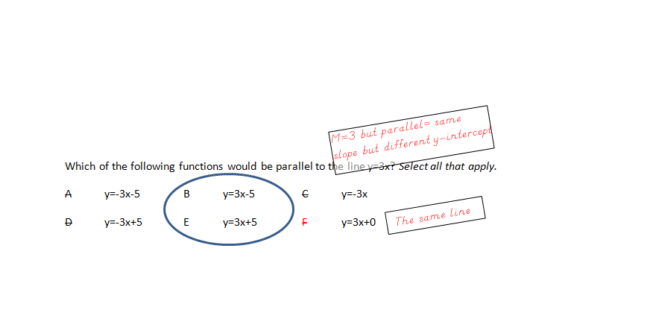10.17.16A Tiny ‘Own and Track’ Moment from Bryan Belanger’s Classroom
I stopped into TLaC 2.0 cover boy Bryan Belanger’s math class this morning for about 10 minutes on my way to a meeting. I observed a tiny moment of brilliance. Here’s what he did.
Bryan gave his students this problem to solve independently:
Which of the following functions would be parallel to the line y=3x? Select all that apply.
A y=-3x-5 B y=3x-5 C y=-3x
D y=-3x+5 E y=3x+5 F y=3x+0
He then cold called students to name the answers that applied. It’s a pretty simple question and most students understood the problem very quickly and eliminated A, C and D, though one student chose A so Bryan quickly reviewed: “What must every answer have to be correct?” he asked. “A slope of three,” a student replied so Bryan annotated the problem, writing “m=3” above the prompt and asking his students to do the same.
But then Bryan challenged his students. “Actually, he said, one of the three you’ve chosen is also not correct. Can anyone tell me which one and why?”
He took hands here and one of his students observed that F had both the same slope but also the same Y-intercept.”
“Yes,” Bryan said. “That’s subtle but important. It’s the same line and a line can’t technically be parallel to itself.” Then Bryan did something really important: he locked down the teaching point through mark-up. He asked students to be sure to cross out F in their packets and to write in the margin, “same line” so they remembered not only that F wasn’t correct but why. Then he had them re-amend the note on the question so that above parallel they wrote: “Same slope but different y-intercept.”
Thus in the end students had in front of them a perfect record of what they’d learned and it looked something like this:

I loved this move. It’s a great example of the technique “Own and Track” (technique #10 in Teach Like a Champion 2.0). It increases to the value of the time Bryan spent talking about wrong answers by making sure that students intentionally noted what they learned during the error analysis and kept a record of it. They knew not only which were right answers, but which one had fooled many of them and why. And they had the rule as they now understood it handy for easy review.
